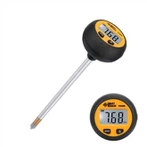Basic principles of digital storage oscilloscope
Digital oscilloscopes follow the sampling principle and use A/D conversion to convert continuous analog signals into discrete digital sequences, and then restore and reconstruct the waveform to achieve the purpose of measuring the waveform.
The input buffer amplifier (AMP) buffers and transforms the input signal to isolate the object under test from the oscilloscope. The change of the oscilloscope's working state will not affect the input signal and at the same time switches the amplitude of the signal to an appropriate level. Range (the range that the oscilloscope can process), that is to say, signals of different amplitudes will be converted into signals within the same voltage range after passing through the input buffer amplifier.
The function of the A/D unit is to convert the continuous analog signal into a discrete digital sequence, and then reconstruct the waveform according to the sequence of the digital sequence. Therefore, the A/D unit plays a sampling role. Under the action of the sampling clock, it converts the signal amplitude at the moment when the sampling pulse arrives into a digital value. This point is called the sampling point. The A/D converter is a key component of waveform acquisition.
The multiplexer (DEMUX) arranges the data in order, that is, the A/D converted data is stored in the memory according to the order on the analog waveform, that is, the addresses are arranged for the data, and the order of the addresses is that the sampling points are on the waveform. In the order above, the time interval between adjacent data at the sampling point is the sampling interval.
Data acquisition memory (Acquisition Memory) is a storage unit that stores sampling points. It stores the sampling data according to the arranged address. When the data in the acquisition memory is enough to restore the waveform, it is sent to the post-processing for restoration. waveform and displayed.
Processor (μP) and display memory (Display Memory). The processor is used to control and process all control information, restore the sampling points to waveform points, store them in the display memory area, and use them for display. The display unit (Display) displays the waveform points in the display memory. There is a one-to-one correspondence between the data in the display memory and the points on the LCD display panel.






